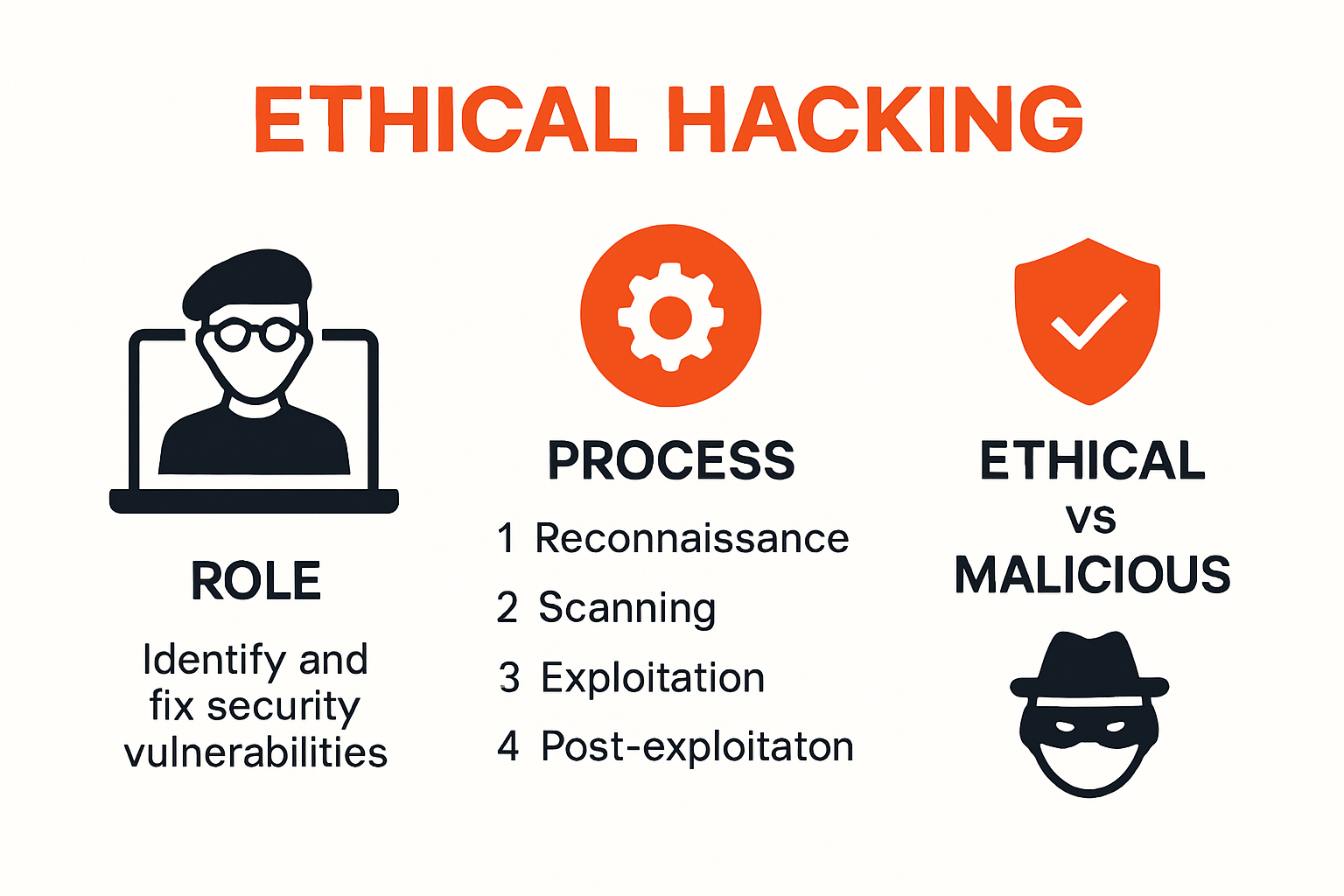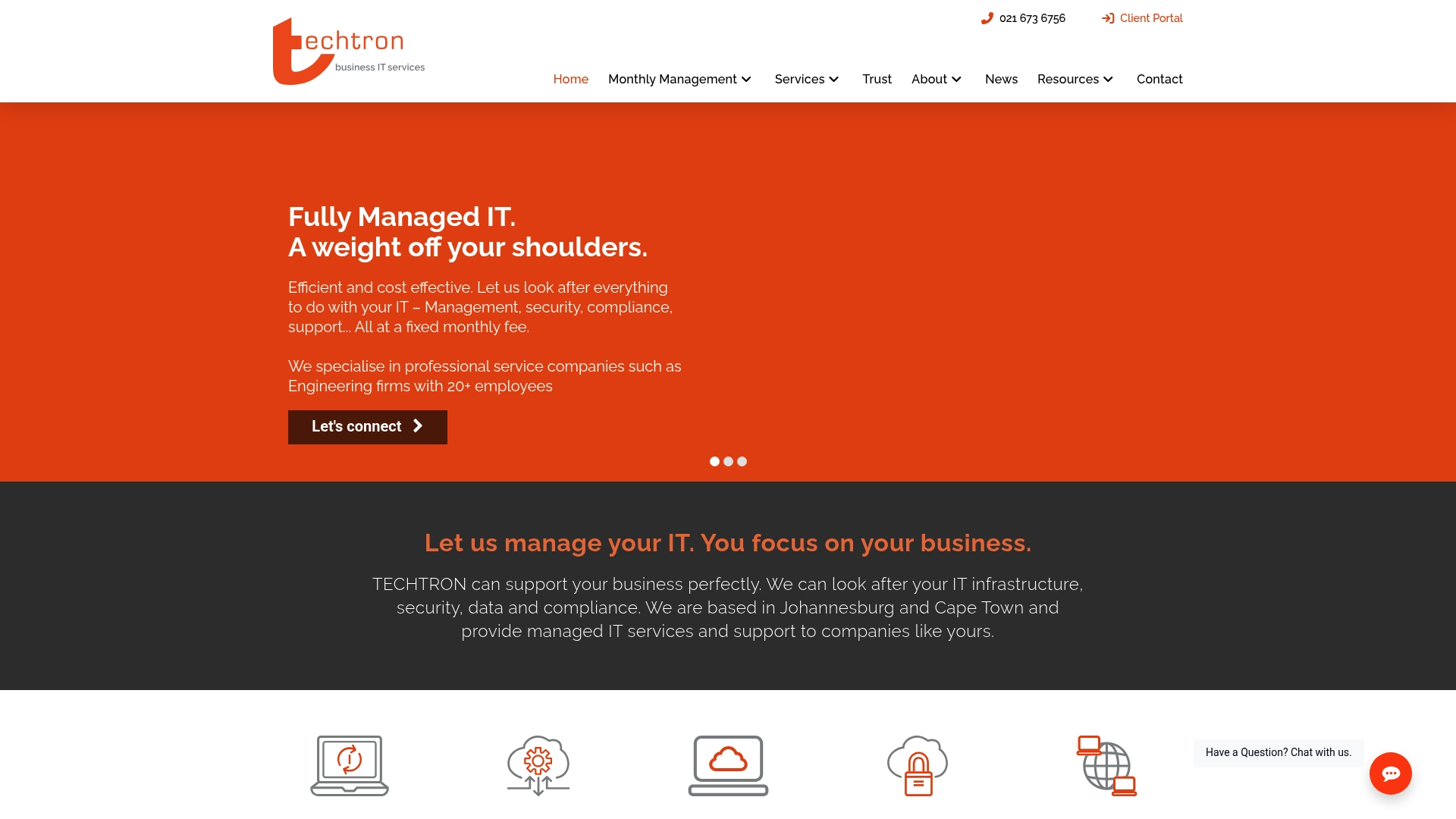Ethical Hacking Basics for Business in 2025
Businesses are racing to tighten up digital security as cyber attacks get smarter and more relentless every year. You might expect expensive firewalls or the latest software updates to be the frontline of defence. But here is the kicker. Regular ethical hacking assessments can cut security breaches by up to 60 percent and it is actually trained professionals, not just fancy tech, who are the real secret weapon in keeping companies safe.
Table of Contents
- Understanding Ethical Hacking In Business
- Common Threats And Vulnerabilities Companies Face
- Key Ethical Hacking Tools And Techniques
- Best Practices For Building A Secure IT Environment
Quick Summary
| Takeaway | Explanation |
|---|---|
| Ethical hacking strengthens cybersecurity effectiveness. | Regular assessments by ethical hackers can reduce security breaches significantly, enhancing overall digital defense. |
| Understand the human factor in cyber vulnerabilities. | Most security incidents stem from human error, making employee training essential for robust cybersecurity. |
| Adopt a proactive approach to security vulnerabilities. | Continuous monitoring and adaptive strategies are critical in anticipating and mitigating emerging security threats. |
| Implement strong security policies and protocols. | Develop and maintain comprehensive security frameworks covering data encryption, access control, and third-party monitoring. |
| Leverage advanced tools for vulnerability assessments. | Utilize tools like Nmap and Nessus for systematic identification and management of potential security weaknesses. |
Understanding Ethical Hacking in Business
Ethical hacking represents a critical strategic approach for businesses seeking to proactively defend their digital infrastructure. Unlike malicious cyber attacks, ethical hacking involves authorized professionals systematically identifying and addressing potential security vulnerabilities before criminal actors can exploit them.

The Strategic Role of Ethical Hackers
Ethical hackers function as digital security architects, employing the same techniques as cybercriminals but with explicit permission and a constructive objective. Research from the Cybersecurity and Infrastructure Security Agency reveals that organizations conducting regular ethical hacking assessments reduce their potential security breaches by up to 60%.
According to the comprehensive study on penetration testing methodologies, ethical hackers typically follow a structured approach involving five critical stages:
- Intelligence Gathering: Collecting comprehensive information about target systems
- Vulnerability Scanning: Identifying potential entry points and system weaknesses
- Vulnerability Exploitation: Simulating potential attack scenarios
- Privilege Escalation: Testing system access controls
- Post Exploitation Analysis: Evaluating potential long term security implications
Here is a table summarising the five key stages of a penetration test and their objectives.
| Stage | Objective Description |
|---|---|
| Intelligence Gathering | Collecting comprehensive information about target systems |
| Vulnerability Scanning | Identifying potential entry points and system weaknesses |
| Vulnerability Exploitation | Simulating potential attack scenarios |
| Privilege Escalation | Testing system access controls |
| Post Exploitation Analysis | Evaluating potential long term security implications |
Ethical Considerations and Legal Frameworks
Professional ethical hacking operates within strict legal and ethical boundaries. The review paper on ethical hacking emphasizes the importance of obtaining explicit organizational consent and maintaining rigorous documentation throughout the security assessment process.
Businesses must establish clear protocols that define the scope of ethical hacking engagements. This includes precise documentation outlining:
- Authorized Testing Parameters: Explicit boundaries of investigation
- Consent Documentation: Written agreements specifying testing limits
- Confidentiality Requirements: Protecting sensitive organizational information
Effective ethical hacking goes beyond technical assessment. It represents a proactive approach to cybersecurity that transforms potential vulnerabilities into strategic opportunities for strengthening organizational resilience. By systematically identifying and addressing security gaps, businesses can develop more robust, adaptive digital defense mechanisms that anticipate and neutralize potential cyber threats before they can cause significant damage.
The strategic value of ethical hacking lies not just in identifying vulnerabilities but in providing actionable insights that enable continuous improvement of an organization’s security posture. As cyber threats continue to evolve with increasing sophistication, ethical hacking emerges as an essential component of comprehensive cybersecurity strategy.
Common Threats and Vulnerabilities Companies Face
In the rapidly evolving digital ecosystem, businesses encounter a complex array of cybersecurity threats that can compromise critical infrastructure, financial stability, and organizational reputation. Understanding these vulnerabilities represents the first crucial step in developing robust defensive strategies.
Sophisticated Cyber Attack Vectors
Modern cyber threats have become increasingly complex and multifaceted. Research from the Global Cybersecurity Report indicates that organizations face an average of 130 targeted cyber attacks annually, with approximately 43% successfully penetrating initial security perimeters.
Businesses frequently encounter several primary threat categories:
- Phishing Attacks: Deceptive communication designed to extract sensitive credentials
- Ransomware: Malicious software encrypting organizational data for financial extortion
- Social Engineering: Psychological manipulation targeting human vulnerabilities
- Network Intrusion: Unauthorized system access through technical exploitation
The National Institute of Standards and Technology Cybersecurity Framework highlights that these threats often exploit interconnected system vulnerabilities, creating potential cascading security risks.
Critical Infrastructure Vulnerability Points
Enterprise technological ecosystems contain multiple potential vulnerability points that cybercriminals systematically target. These include:
- Legacy Systems: Outdated technological infrastructure with unpatched security weaknesses
- Third Party Integrations: External software connections presenting potential entry points
- Cloud Service Configurations: Misconfigured cloud environments enabling unauthorized access
- Remote Work Infrastructure: Decentralized network environments with reduced direct monitoring
Statistical analysis reveals that approximately 60% of data breaches involve unpatched system vulnerabilities or misconfigured network settings. Organizations must continuously monitor and update their technological infrastructure to mitigate these risks.
Human Factor in Cybersecurity Vulnerabilities
Despite advanced technological defenses, human behavior remains the most significant security vulnerability. Cybersecurity behavioral research demonstrates that employee actions contribute to approximately 95% of security incidents.
Common human-related vulnerability factors include:
- Inadequate Security Training: Limited understanding of potential cyber risks
- Password Management Failures: Weak credential selection and reuse
Businesses must recognize that technological solutions alone cannot guarantee comprehensive protection. A holistic approach integrating technological defenses, continuous employee education, and proactive threat monitoring becomes essential.
Effective vulnerability management requires a dynamic, adaptive strategy that anticipates emerging threats and systematically addresses potential weaknesses across technological, procedural, and human domains. By understanding these complex threat landscapes, organizations can develop more resilient, comprehensive cybersecurity frameworks that protect critical digital assets and maintain operational continuity.
Key Ethical Hacking Tools and Techniques
Ethical hacking requires a sophisticated arsenal of specialized tools and techniques designed to systematically identify, assess, and mitigate potential security vulnerabilities. Professional ethical hackers leverage a comprehensive toolkit that enables comprehensive security assessments across complex technological environments.
Foundational Scanning and Assessment Tools
The E&ICT Academy at IIT Kanpur highlights several critical tools essential for effective security evaluations:
- Nmap: Network mapping and discovery tool for identifying active systems and potential entry points
- Nessus: Comprehensive vulnerability scanning software
- Wireshark: Advanced network protocol analysis for detecting unusual communication patterns
- Burp Suite: Web application security testing platform
These tools enable ethical hackers to conduct systematic reconnaissance and vulnerability identification across network infrastructures. Research from the PenTest++ study emphasizes the growing importance of integrating artificial intelligence and automation capabilities within these traditional scanning frameworks.

The following table provides a quick summary of foundational ethical hacking tools and their main purposes.
| Tool | Main Purpose |
|---|---|
| Nmap | Network mapping and identifying active systems & entry points |
| Nessus | Comprehensive vulnerability scanning |
| Wireshark | Network protocol analysis and detecting unusual communication |
| Burp Suite | Web application security testing |
Penetration Testing Methodological Approaches
According to the comprehensive penetration testing research, ethical hackers employ a structured five stage methodology:
- Intelligence Gathering: Collecting comprehensive target system information
- Vulnerability Scanning: Identifying potential security weaknesses
- Exploitation Techniques: Simulating potential breach scenarios
- Privilege Escalation: Testing access control mechanisms
- Post Exploitation Analysis: Evaluating potential long term security implications
Each stage requires specialized tools and techniques that allow systematic and controlled security assessments. Advanced ethical hackers utilize a combination of automated scanning tools and manual investigative techniques to provide nuanced security insights.
Advanced Technological Capabilities
Modern ethical hacking transcends traditional tool usage by incorporating sophisticated technological approaches. Emerging methodologies integrate artificial intelligence and machine learning algorithms to enhance detection capabilities and predictive security modeling.
Key technological capabilities include:
- Automated Vulnerability Detection: AI powered scanning mechanisms
- Behavioral Analysis Tools: Advanced threat pattern recognition
- Continuous Monitoring Systems: Real time security assessment platforms
Businesses must recognize that effective ethical hacking represents more than technical tool application. It requires a holistic approach combining technological sophistication, strategic thinking, and comprehensive understanding of complex security ecosystems.
The evolution of ethical hacking tools continues to reshape cybersecurity strategies. By embracing advanced technological capabilities and maintaining a proactive, adaptive approach, organizations can develop robust defense mechanisms that anticipate and neutralize emerging cyber threats with unprecedented precision and effectiveness.
Best Practices for Building a Secure IT Environment
Building a secure IT environment requires a comprehensive, multilayered approach that integrates technological solutions, strategic planning, and continuous organizational learning. Businesses must develop robust defensive strategies that anticipate and neutralize potential cybersecurity threats across multiple operational domains.
Fundamental Security Infrastructure Components
Indiana University’s Information Security & Policy department recommends implementing critical foundational security practices that form the backbone of organizational digital defense:
- Data Encryption: Protecting sensitive information across storage and transmission channels
- Software Maintenance: Regularly replacing outdated or insecure software systems
- User Account Management: Implementing strict access control procedures
Research from Caltech’s Cybersecurity Framework emphasizes the importance of developing comprehensive security policies that address multiple potential vulnerability points. These policies should include:
- Robust password management protocols
- Multi factor authentication requirements
- Detailed third party application monitoring procedures
Advanced Security Configuration Strategies
Effective IT security extends beyond basic protective measures. Organizations must develop sophisticated, adaptive security configurations that can respond dynamically to emerging technological challenges. Key strategic approaches include:
- Continuous Vulnerability Assessment: Regular systematic security evaluations
- Network Segmentation: Isolating critical system components
- Zero Trust Architecture: Implementing strict verification for all system access requests
Technological infrastructure requires ongoing monitoring and adaptive configuration. Security is not a static condition but a continuous process of assessment, improvement, and strategic refinement.
Human Factor Security Integration
Technological solutions alone cannot guarantee comprehensive protection. Human behavior represents a critical component of organizational cybersecurity. Businesses must invest in comprehensive security awareness programs that transform employees from potential vulnerability points into active security participants.
Effective human factor security integration includes:
- Regular Security Training: Comprehensive educational programs
- Simulated Threat Scenarios: Practical learning experiences
- Clear Reporting Mechanisms: Structured incident communication protocols
Successful secure IT environments recognize the interconnected nature of technological systems and human behavior. By developing holistic strategies that combine advanced technological solutions with continuous learning and adaptive approaches, organizations can create resilient digital ecosystems capable of withstanding increasingly sophisticated cyber threats.
The ultimate goal of building a secure IT environment transcends mere defensive protection. It involves creating an adaptive, intelligent infrastructure that can anticipate, respond to, and neutralize potential security challenges with unprecedented efficiency and precision.
Frequently Asked Questions
What is ethical hacking and how does it benefit businesses?
Ethical hacking involves authorized professionals testing systems for vulnerabilities to prevent cyber attacks. It significantly reduces potential security breaches and strengthens overall digital defenses.
Why should my business conduct regular ethical hacking assessments?
Regular ethical hacking assessments can cut security breaches by up to 60%. They provide proactive insights to address vulnerabilities before they can be exploited by malicious actors.
What common threats do companies face in cybersecurity?
Companies face various cyber threats, including phishing attacks, ransomware, social engineering, and network intrusions, which can exploit vulnerabilities in interconnected systems.
How can employees contribute to cybersecurity in the workplace?
Employees can improve cybersecurity by undergoing regular training on security protocols and best practices. This helps mitigate risks associated with human error, which accounts for 95% of security incidents.
Secure Your Business Future with Proven Ethical Hacking Practices
Your business faces growing threats from complex cyberattacks and costly human errors, just as described in our article on ethical hacking. If managing digital risk is starting to feel overwhelming, you are not alone. With attackers constantly targeting vulnerabilities and employees being a frequent entry point, there is no room for guesswork when it comes to protection. The article shows that simply updating software will not shield you from today’s sophisticated scams and ransomware. Only a proactive and strategic approach can give you real confidence.

Take a practical step towards a safer business environment. Partner with Techtron and access professional managed IT services that directly address these modern threats. We specialise in proactive cybersecurity, continuous monitoring, and best-in-class network protection. All tailored to support fast-moving engineering and financial firms who cannot afford downtime. Visit our landing page to see how our solutions translate ethical hacking principles into daily business security. Do not wait until your next audit or attack. Let our experts take the pressure off you. Request a consultation now to make your IT resilience a competitive advantage.